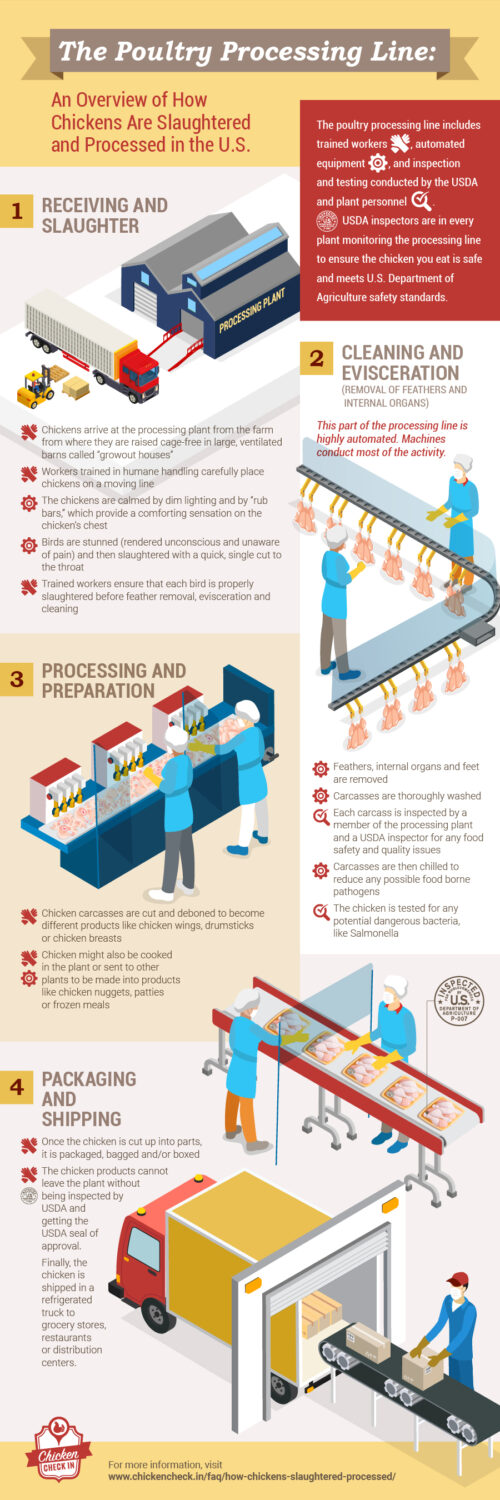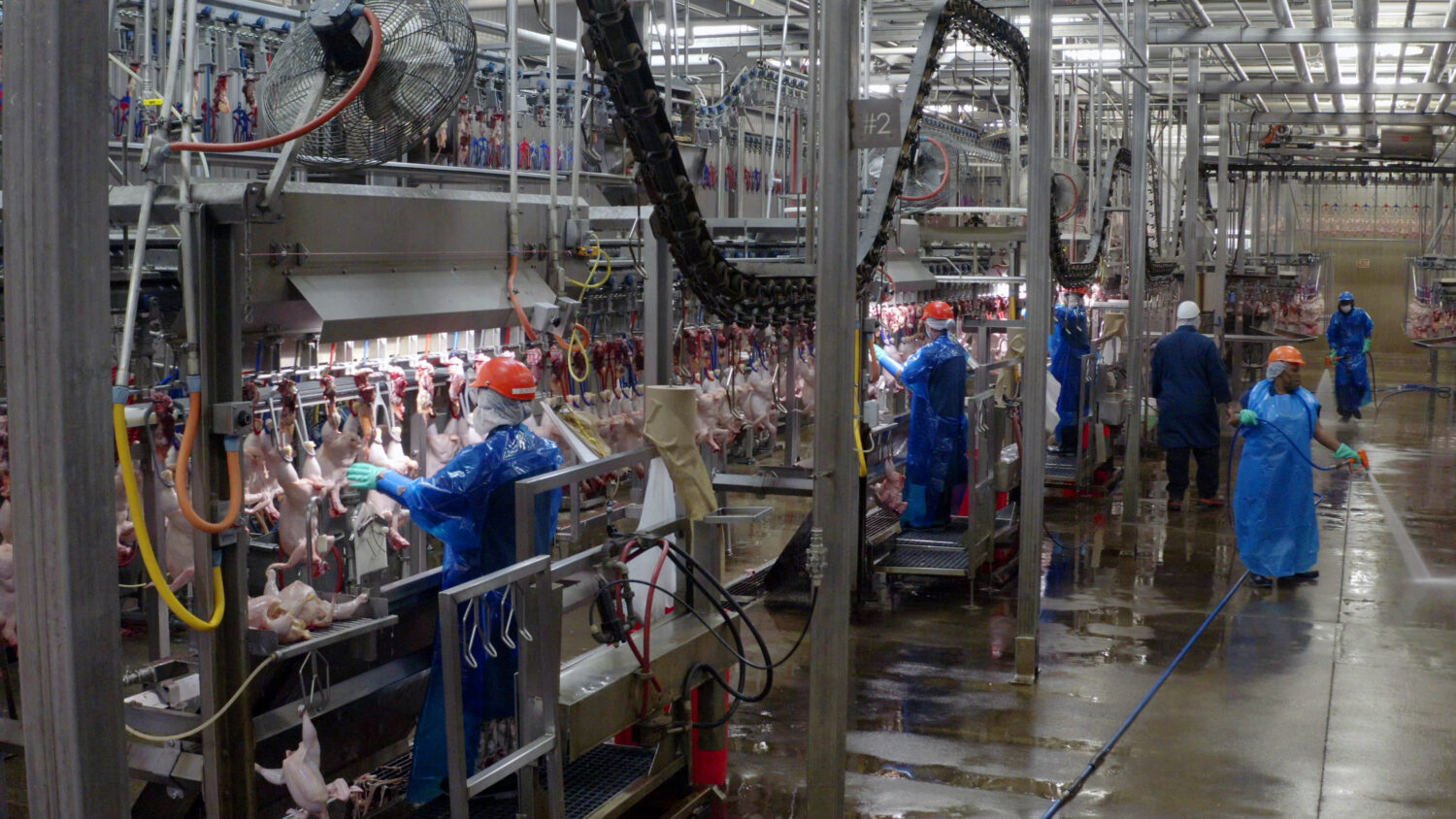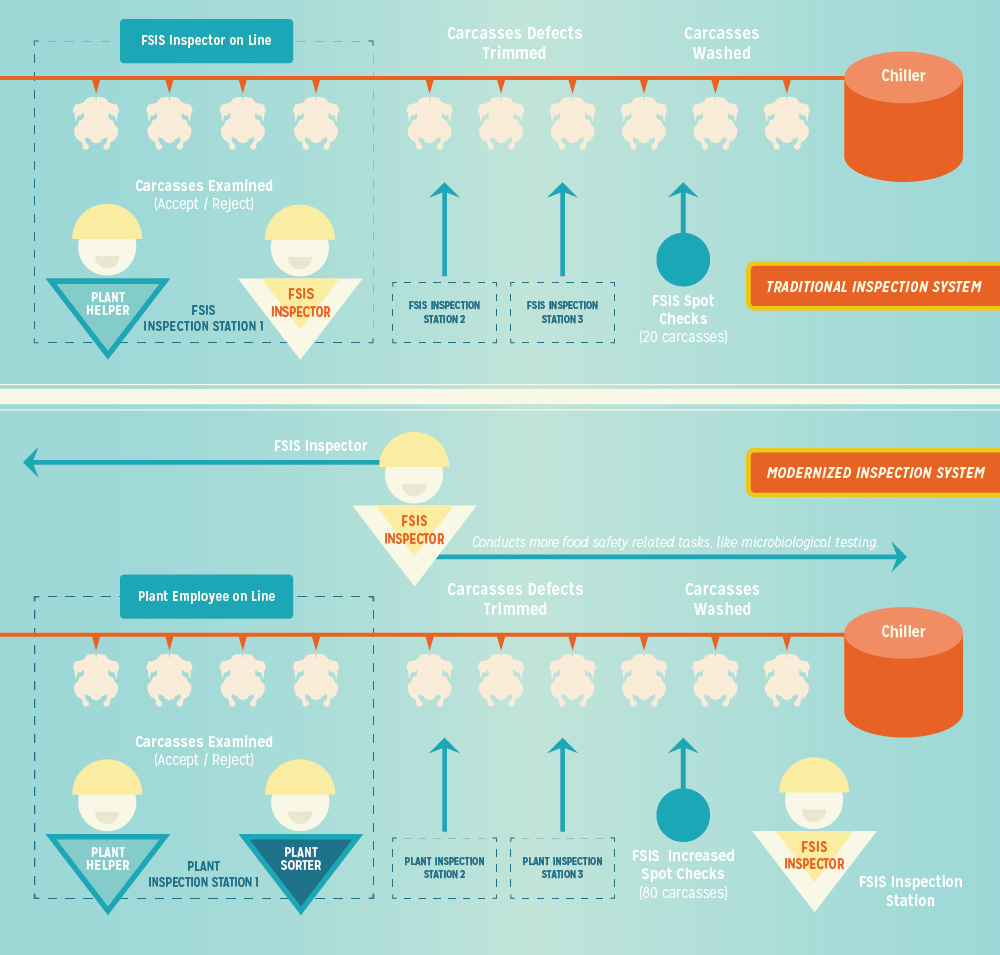Processing: How are chickens slaughtered and processed for meat?
Broiler chickens (the type raised for meat) generally take up to seven weeks to reach market weight. Once they’ve reached the proper size and weight, workers trained in humane care arrive to catch each chicken at the farm, by hand. During this process, chickens are transferred into holding cages or modular bins, specifically designed for transport to the processing plant, aimed to ensure that birds don’t hurt themselves or other birds, and that air is able to circulate.
To help explain the rest of how chickens are slaughtered and processed for meat in greater detail, we’ve broken into the 10 main steps.
Step 1: Arrival at the Processing Plant
Just as careful attention is paid to the welfare of chickens while being raised on the farm, the same is true for their short trip to the processing plant. This trip is typically less than 60 miles away, so the birds don’t travel long distances.
Step 2: Stunning
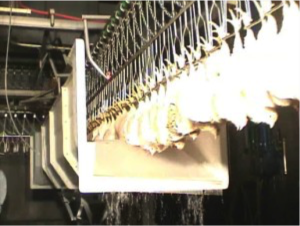
Once birds arrive at the processing plant, workers trained in humane handling carefully suspend them by their feet on a moving line. In a matter of seconds, the chickens become calm due to “rub bars,” which provide a comforting sensation on the chicken’s chest. This, combined with low lighting, is used to keep birds calm.
In modern poultry processing plants, every attempt is made so that chickens are processed quickly and painlessly. First, they are rendered unconscious and unaware of pain, prior to slaughter.
There is one primary method of stunning broilers prior to slaughter in the U.S. and that is “electrical stunning.” It is the predominant method of rendering birds unconscious. There are a limited number of facilities in the U.S. that utilize controlled atmosphere stunning (CAS) systems for broilers. These systems utilize carbon dioxide to render birds insensible. Another CAS system utilizes a reduction of atmospheric pressure to stun birds.
When operating properly, both systems are equally humane as both require monitoring, proper adjustment and management to ensure they are meeting humane care standards.
Step 3: Slaughter
Technology makes slaughter extremely quick to minimize discomfort. While making a single cut to the throat of an unconscious bird is largely effective, should the blade miss for any reason, trained workers stand by to quickly euthanize remaining birds. Proper maintenance of equipment and this back-up “human” system is key to a fast and humane slaughter process.
Step 4: “Evisceration”
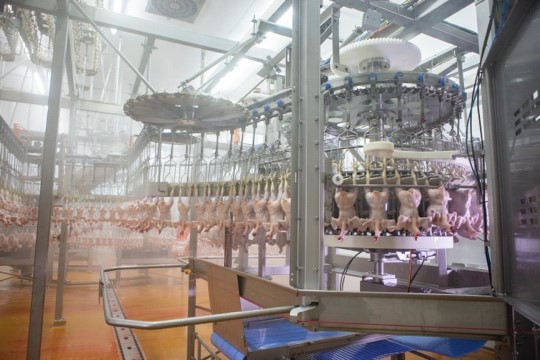
After slaughter, birds enter a process where their feathers are removed. This is necessary in order to prepare the bird for processing. This begins by putting the chicken through a bath of hot water, which is designed to help loosen feathers. Feather removal is performed by a machine called a “picker,” which includes hundreds of little rubber “fingers” that rotate around to remove the feathers.
After feathers are removed, the birds are sent to an “eviscerating” line which removes internal organs and feet, also known as “paws.”
Every single part of the bird is used —for example, chicken feet are considered a delicacy in Asian countries, and feathers are rendered and used as protein in some animal feed.
Step 5: Cleaning and Chilling
After the organs are removed, the carcasses are then cleaned before being inspected. As an added measure to further reduce bacteria, water and an organic rinse may be applied to each bird. Any substance used for this purpose is closely regulated by both the USDA and Food and Drug Administration (FDA) and has been approved for use in food production.
Research has confirmed that the use of these rinses do not pose human health concerns; rather their use does improve the wholesomeness of finished products. Before this process, which includes chilling the birds to a lower temperature to keep fresh and clean, company quality assurance and food safety personnel inspect them once again for quality, food safety and wholesomeness. They follow strict regulatory and company standards for each bird entering the chilling process.
Step 6: Inspection by the U.S. Department of Agriculture (USDA)
During the evisceration process, each bird is inspected by both a member of the processing plant and a USDA inspector. USDA inspectors visually evaluate every inch of each chicken to look for diseases, fecal matter or bruising.
Any birds flagged with issues are removed from the line, condemned, and the issue addressed. It’s important to remember that chickens today are the healthiest they’ve ever been – condemned parts are only a fraction of one percent of total production.
This infographic demonstrates each step of the modern poultry inspection process:
Step 7: Additional Testing
After chickens are chilled, microbiological tests to further ensure food safety are conducted on equipment and products at chicken plants by companies and by the USDA. This includes tests for microorganisms such as Salmonella.
Due to the effectiveness of these processes, the industry experiences a very small percentage of positive Salmonella results, when compared to overall production. According to the most recent USDA data, large establishments (which reflects most of U.S. chicken production) had 2.7 percent positive tests for Salmonella on whole birds. This is well below the 7.5 percent standard set forth by the USDA.
As a reminder, all chicken is safe to eat when it is properly handled and cooked to an internal temperature of 165 degrees Fahrenheit. While the industry goes to great lengths to control microorganisms responsible for foodborne illness before chicken products leave the plant, it’s equally important for consumers to adhere to these very simple cooking instructions to ensure overall food safety.
Step 8: “Second Processing”
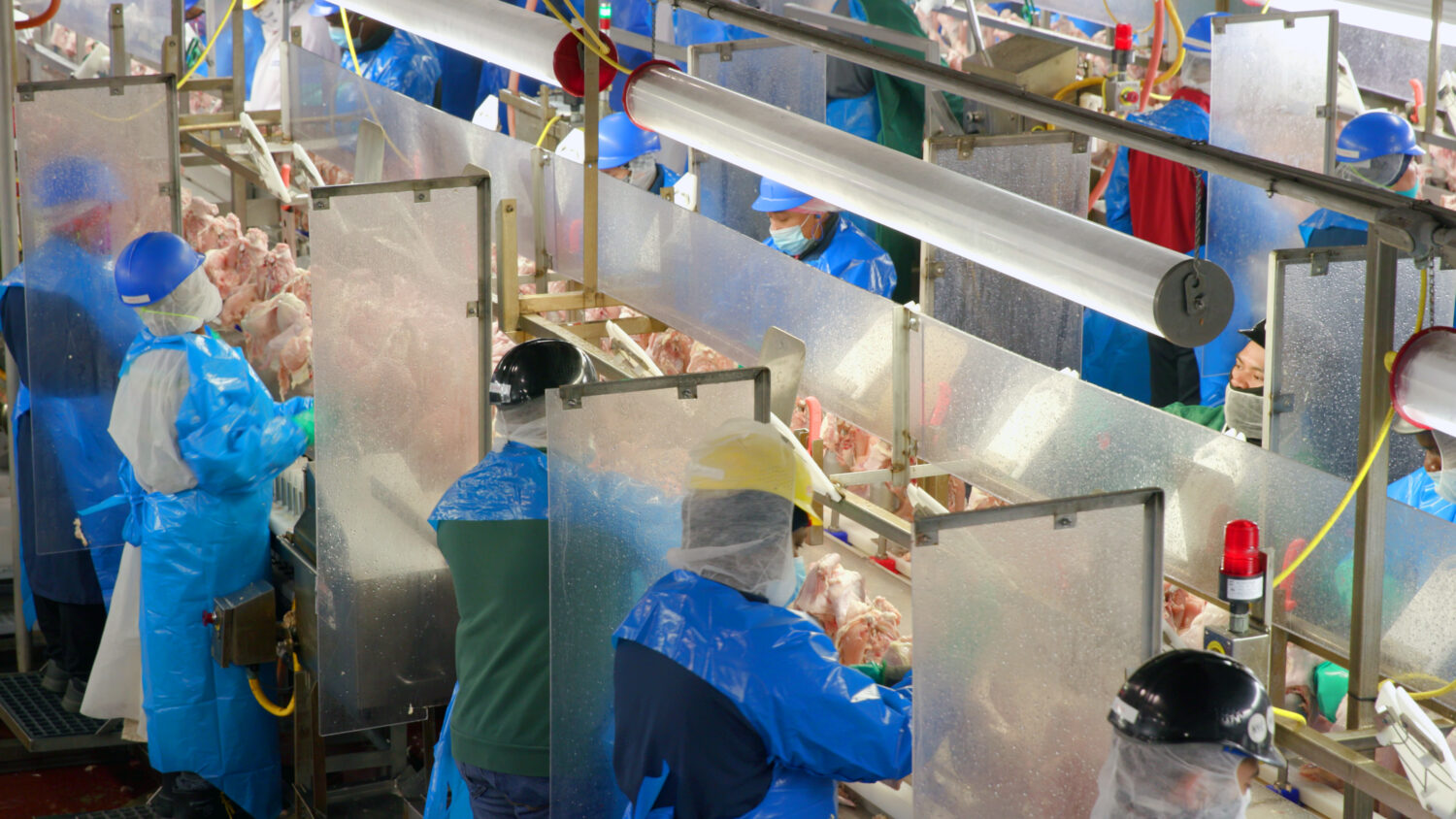
After properly tested and chilled, the carcass is typically cut and deboned to accommodate a variety of different products. Depending on the processing plant, these products may include the fresh or frozen chicken sold in stores, chicken used in restaurants or exported. This includes convenience products sold in “tray-packs” most commonly seen at your local grocery stores, such as drumsticks, thighs, leg quarters, wings, breasts and more.
All-in-all, before reaching consumers, each piece of chicken is inspected for quality, wholesomeness and food safety with more than 300 safety checks throughout the entire process.
Step 9: Packaging
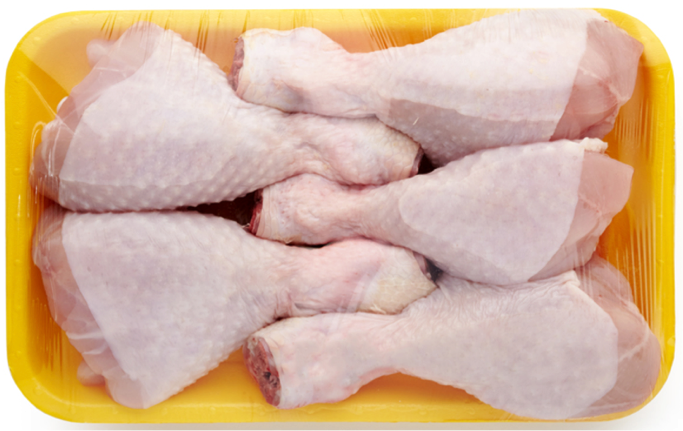
Once chicken is cut up into parts, it is packed in trays and wrapped. The wrapped product is then inspected again to ensure that it meets or exceeds both consumer and customer expectations.
Wrapped product is placed into baskets and sent through a “blast tunnel” to receive a chill. This is done so that the product can have an extended shelf life by keeping it fresh longer. Though the product is significantly cooled during this process, it does not freeze.
After the product is properly chilled, it is weighed and price and safe handling instructions are affixed to the package. Labels on chicken packages must be approved by USDA prior to application on a product.
The product then passes through a metal detector for one final check to ensure that there is nothing present in the package that doesn’t belong there.
Finally, the product is packaged into boxes where a label is placed on the exterior of the box. This label displays the date packaged, USDA seal of approval and the establishment number of the plant, so that the product can be traced to the establishment where it was produced.
Step 10: Shipping
Finally, the chicken is on its way to your local market. Prior to loading the finished product on trucks, trailers are inspected to ensure they are functioning correctly, and are properly cooled and cleaned.
Once a shipment load is completed, the trailer is sealed with a tamper-evident seal. The seal is not broken until the product arrives at the customer, in order to ensure product safety and wholesomeness.
Retail products are usually delivered to a retailer’s warehouse the day after leaving the production plant. Most often, chicken products get placed into company grocery stores the same day of delivery.
If you’re interested in seeing how chickens are processed, you can watch this video. This video was filmed pre-COVID-19.
At Every Step of the Processing Line, Employee Safety Always Comes First
Keeping employees safe and healthy has always been the chicken industry’s top priority. Each chicken company is committed to protecting their employees, ensuring they are in a position to continue supplying safe, affordable, and high-quality chicken.
In response to COVID-19, each chicken company has added additional protective measures to help keep employees safe and healthy. Companies are following all of the CDC and local health department guidelines, and many have consulted with infectious disease physicians to develop site plans.
See how the chicken industry has enhanced safety measures in response to COVID-19.
For more about how chickens in the United States go from farm to table, check out this infographic on the journey of the All-American Chicken.

